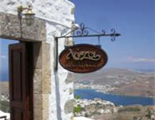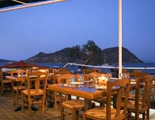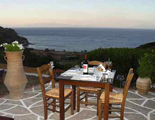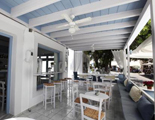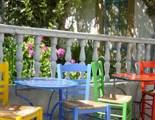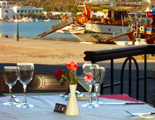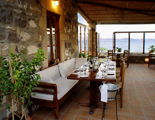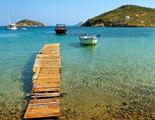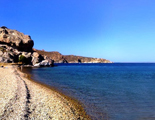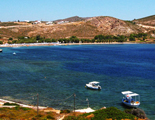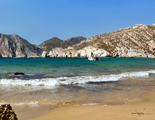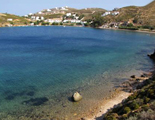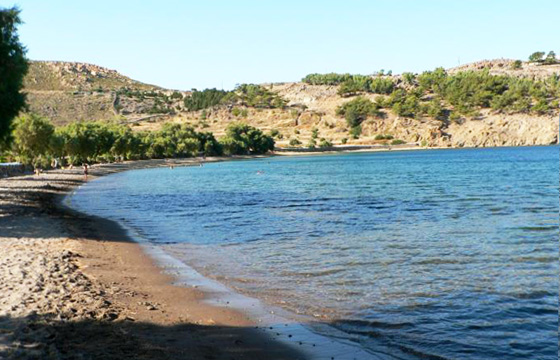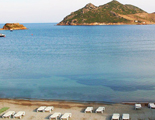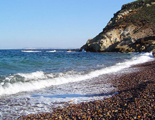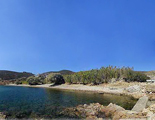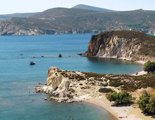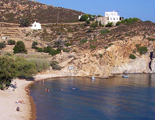 Patmos Travel Guide
Patmos Travel Guide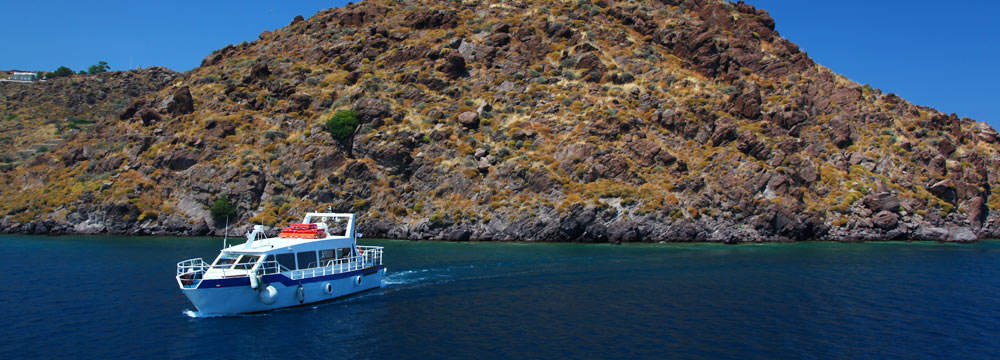
There are many versions concerning the name of Patmos, the most popular of which are connected with God Poseidon and Goddess Artemis.
According to the Greek mythology, the word Patmos symbolizes the fact that God Poseidon stepped his feet (the verb “pato” means “step” in Greek) on this island for the first time.
Another myth has it that Patmos or Pantos was another name for Goddess Artemis. Artemis, together with Poseidon were supposed to be the first inhabitants of the island, thus the island was named after that.
Another tradition supports that Patmos owes its name to Latmos, a mountain of Karia (an area of Mikra Asia opposite the island), whose worshipped Goddess Artemis. A variation of that tradition states that Patmos was a word used in the language of the inhabitants of Karia and meant “area with coniferous trees”.
The first inhabitants of Patmos according to Greek mythology were Poseidon and Artemis. In the 3rd millennium B.C. Karians came to Patmos from Asia Minor, followed by Dorians after 1400 B.C. and Ionians from Militos.
In 95 A.C. Ioannis Theologos was exiled in Patmos, heard the voice of God and wrote the Apocalypse at the renowned Cave of the Apocalypse.
Prehistoric ruins at Kastelli prove that Patmos was already inhabited in the Middle Bronze period. Karians were the first confirmed inhabitants of the island, in the 3rd millennium B.C., followed by Dorians and Ionians. Patmos was very powerful in economic terms during the Hellenistic years, when it belonged to the territories controlled by Miletus, and Lakedemonians used to refuge to the island during the Peloponnesian War. Right after that, pirates invasions devastate the island and very few of its former inhabitants remain on it. In the 2nd century B.C. the Romans use Patmos as an exile place.
A new period of glory began in 95 A.C., when Ioannis Theologos was exiled in Patmos and wrote the Apocalypse. Christians then started coming to the island building many orthodox churches that have remained till nowadays. After the Christian “invasion” between the 6th and 9th century A.C. the island is depopulated and attacked by pirates.
10th -12th century: In 1088, Patmos was granted to Osios Christodoulos, who founded the Monastery of Saint Ioannis Theologos. This was the beginning of a period of grand prosperity that built the basis of growth and welfare for the centuries to come.
Patmos was a powerful commercial center, occupied in 1207 by the Venetians and became a semi-autonomous state. The “knights of Saint John” occupied the island in 1340 and kept it until 1522, when the Ottomans came. Venetians reoccupied Patmos in 1659 and almost destroyed it.
17th-18th century: A new period of prosperity, during which “Patmiada Scholi”, meaning “The School of Patmos” in Greek, is founded in 1713 by Makarios Kalogeros (Makarios the Monk). For many years this school was providing high level education to Greeks and was a place of maintaining and passing from generation to generation the Greek culture and traditions. In 1770, after the end of the wars between Venetians and Ottomans, Patmos came under the Russian rule. Recent History Patmos participated in the Greek revolution in 1821 but since the treaty of London did not include the Dodecanese Islands in Greece’s borders, Patmos fell again under Ottoman domination. The island was under the Turkish rule till 1912, when the war between Italians and Turks took place and Italians took over control of all the Dodecanese.
After Italians, the Germans came to Patmos and took the authority till 1945 when the island was freed at last and remained independent and autonomous for only a few years. In 1948 all Dodecanese Islands were integrated in Greece’s territory and have remained like this since then.
One of the most popular myths concerning Patmos Island is the one related to Goddess Artemis. Patmos was believed to have sunk into the sea but Artemis saved it and brought it back to the surface using her divine touch. Ever since, Goddess Artemis is believed to be the island’s protector.
Another myth has it that Orestis, who killed his mother Clytemnestra, escaped and lived in Patmos.
Patmos is known as the “Island of the Apocalypse” and attracts tourists from all over the world just for this reason. However, it is a very picturesque island, with traditional white houses, crystal blue waters, vibrant nightlife and gastronomic surprises.
It is believed to have been the sacred cave where Saint Ioannis heard the voice of God and wrote the Apocalypse. In the cave, visitors can admire the cross engraved by Saint Ioannis, as well as the three small cracks on the rock through which the voice of God came, symbolizing Holly Trinity. A visit to the Cave is really a unique unforgettable experience.
Built in the 11th century, this monastery dominates the high cliff above the island capital and resembling a medieval castle. The monastery has been declared a world heritage monument by UNESCO. It houses 10 chapels, a laboratory of pottery, the Ecclesiastical Museum with a treasure of orthodox icons, embroideries and objects used for religious purposes.
Located in the monastery of Saint Ioannis, the Ecclesiastical Museum houses a treasure of religious objects including icons, church utensils, vestments and embroideries, as well as important manuscripts.
Strategically situated at the northern part of Hora, the ancient acropolis has a view to all three bays (Skala, Hohlaka and Merika), while it is dated back to the Middle Bronze Period. Visitors can see the ruins of the ancient fortification wall, towers and one gate, but Kastelli is also the ideal place to watch the sunset.
In this area of Western Patmos, ruins of prehistoric accommodations have been discovered. A genuine travel back to time!
On this rock featuring carved stairs, caves and wells, ceramic utensils of 1100 B.C. have been found as well as tools made of stone.
Housed in the Semantiris Residence, built in the 17th century by craftsmen from Smyrni, the Museum hosts paintings, old furniture and objects of the island’s everyday life through the centuries.
Skala is the port of the island, pretty famous for its unique architecture. Among its beautiful buildings, the “Italian” building that houses the Post Office, the Hellenic Tourism Organization and local authorities stands out. It was built in 1932, boasts a three-floor tower and many arches at the ground floor.
The island’s capital is among the most picturesque island capitals in Greece. With its whitewashed houses of traditional Greek insular architecture and its mansions made of stone, Hora is connected to Skala with a narrow street. At Hora, visitors can also see the house of Emmanuel Xanthos, one of the founders of “Filiki Eteria”.
CLIMATE
Patmos has a mild Mediterranean climate, enjoying about 3000 hours of sunshine per year. During the summer (starting in late May), the atmosphere is limpid and the sea temperature is ideal for swimming until October. Like in most Aegean islands, the sea is not calm during the afternoons in August due to a local wind called “meltemi”. There are about 80 days of rain per year, mainly in the period between November and February.
TELEPHONE
The national prefix for Greece is +30 if you are calling from abroad. All numbers in the capital Athens start with the prefix 210 and are followed by 8 digits (e.g. 210-3227400).
The Area Code for Patmos is: +30 22470. If you wish to call abroad, you have to start by dialing the other country’s national prefix (i.e. 0049 for Germany, 0044 for England etc.) and continue with the area code and the number where you wish to call.
CURRENCY
Euro €
Euro Coins: 1 and 2 euro coins (gold and silver color), 10, 20 and 50 cents (gold color) 1, 2 and 5 cents (copper color)
1 euro = 100 cents / centimes.
Euro Bank Notes: Are available in 5, 10, 20, 50, 100, 200 and 500. It is not always easy to receive change for 200 and 500 Euro Notes.
BY AIR
Patmos does not have an airport. The closest airport is the airport of the island of Leros, but flights are more frequent from Athens or from airports abroad towards Kos, Rhodes and Samos. Local itineraries connect Patmos to the aforementioned islands on a daily basis during the summer. For more information on flights to the airports close to Patmos, please visit:
Athens International Airport Eleftherios Venizelos: www.aia.gr
Olympic Airways: For accurate timetable and ticket costs visit Olympic Air website www.olympicair.com
Athens Office: +30 210 355 0500, 8018010101
Aegean Air: For accurate timetable and ticket costs visit Aegean Air website www.aegeanair.com
Tel.: 801 112 0000/+30 210 6261000
BY BOAT
Patmos is connected by boat with Piraeus, the other islands of the Dodecanese, but also with other islands of the Aegean Sea, like Samos and Ikaria. The boat from Piraeus takes about 7 hours to reach the port of Patmos in Skala. The trips from the nearby islands of the Dodecanese last about 1-1.5 hours, while the trips from Ikaria or Samos last a little longer.
BLUE STAR FERRIES: For accurate timetable and ticket costs visit Blue Star Ferries website www.bluestarferries.gr
Tel.: 18130 / +30 210 8919800, 210 -4274009-010
E-mail: [email protected]
Anek Lines: For accurate timetable and ticket costs visit Anek Lines website www.anek.gr
Tel.: +30 210 4197470
E-mail: [email protected]
Dodecanese Seaways: For accurate timetable and ticket costs visit Dodecanese Seaways website www.12ne.gr
Tel: +30 22410 70590 (Rhodes Headquarters)
E-mail: [email protected]
Useful telephone numbers:
Piraeus Port Authority: +30 210 42 26000
Patmos Port Authority: +30 22470 31231
Patmos is a small island and has a good network of local transportation. Buses depart from Skala to Hora, Groikos and Kampos, and pass through many villages / beaches in-between.
You may also use the Boat Owners Association to organize your own boat trip to little islands around Patmos, or enjoy the boat trip around the island.
For more information:
LOCAL BUSES: +30 22470 31666
TAXI SERVICE: +30 22470 31225
BOAT OWNERS ASSOCIATION OF PATMOS: +30 22470 32664 FERRY-BOAT
There is a daily connection with Leipsous with the boat Patmos Express that departs at 10 a.m. and departs at 4 p.m. every day during the summer months.
RENT A CAR/MOTORBIKE
Patmos is ideal for renting a car or a motorbike. Please note that local authorities are very strict concerning the use of helmets while riding a motorbike.
BANKS & ATMS
The following banks have branches and ATMs in Patmos:
National Bank of Greece: In Skala. Tel.: +30 22470 34040
Commercial Bank (Emporiki Bank): In Skala. Tel: +30 22470 34140, +30 22470 35000
Dodecanese Cooperative Bank: In Skala. Tel: +30 22470 33370
MONEY EXCHANGE
Money can be exchanged in the bank branches listed above.
POST OFFICE
The Greek post office is called ELTA. A wonderful building of Italian architecture, known as the “Italian building”, houses the post office of Patmos in Skala, along with other public services offices.
Post Boxes in Greece are YELLOW for normal post, usually with 2 slots for INTERNAL POST (meaning inside Greece) and post for ABROAD. RED Post Boxes are rarer and they are used for URGENT mail. You shouldn’t expect to find such boxes in the island. REGISTERED mail is always handled and given a receipt for at the POST OFFICE.
Post Office in Patmos Tel. no: +30 22470 31316
POLICE STATION
The Police Station is accommodated in the same building with the Post Office in Skala. Tel.: +30 22470 31303.
MUNICIPALITY OF PATMOS
The Municipality of Patmos has a user friendly portal, which contains useful information: www.patmos.gov.gr
The Municipal building is located in Hora.
Tel.: +30 22470 31235
- Radio Taxi: +30 22470 31225
- Tourist Police: 171
- Port Authority: +30 22470 31231
- Hellenic National Meteorological service: +30 210 9699101-3
- Elpa (Car breakdown tourist information service): 174
International press is hard to find on the island, so visitors should think in advance and take it with them before arriving at Patmos.
EMERGENCY NUMBERS
- Police: 100
- Fire Department: 199
- Ambulance: 166
Patmos Health Center: +30 22470 31211, 22470 32669
There are two pharmacies in Patmos, both in Skala:
- Kleopatra & Stylianos Karafotakis, Tel.: 22470-31650. Mob.: 6974557351
- Christodoulos, Pelagia & Konstantinos Voutzoulidis, Tel.: 22470 31500, 22470 31083
This is a tranquil sandy beach, with calm and clean waters. All the cliffs that surround the area are filled with trees, making the green of the trees and the blue of the sea the dominant colors. Perfect for relaxation and tranquility, Livadi Geranou beach is the place to be in order to enjoy a calm swim protected from Meltemia winds especially during August. A small tavern located near the beach will add a hint of fresh fish and local delicacies to this small heaven.
Petra is an organized beach with large white pebbles. At one end of the beach there is a huge rock, "Petra" (that means stone in Greek), a true challenge for visitors that choose to climb on. The view from the rock is amazing. Petra hosts crows and other wild birds, so we suggest visiting the place to admire the beautiful scenery and the exceptional natural environment.
Agriolivado is an organized sandy beach, with relatively warm shallow waters. The view to the little island of Saint Thekla is magic and there is also a nice beach on the island accessible with a canoe from Agriolivado. Moreover, around Agriolivado there are many bights and bays waiting to be explored.
Psili Ammos is a secluded sandy beach with turquoise waters, accessible only by boat (a 45 minutes boat trip from Skala) or by bus to Diakofti and then walking for about 20-30 minutes through a path that leads to the beach. There is a tavern that separates the beach in two parts, one of them being used by nudists. Psili Ammos is not recommended when it is windy and on Sundays of August, because it is too crowded.
Sapsila is a tranquil sandy beach at Eastern Patmos. It is easily accessible and is one of the two beaches on the island where the sea water is not ice cold. Sapsila village is a small and quite fishing settlement that offers a well developed infrastructure to facilitate visitors and make their visit a pleasant and relaxing experience. Seaside taverns, quality accommodation units and a traditional ambience combined with a charming coast will surely leave the sweetest taste!
Meloi is an easily accessible beach and hosts 2 taverns and the unique organized camping of the island. It is very rarely windy and has shallow waters that are ideal for children. The morphology of the beach includes rocks, sand and little pebbles, while tamarisk trees invite visitors to rest under their shade.
Grikos is a picturesque fishing village with a big sandy beach and many smaller sandy beaches next to it. It owes its cosmopolitan flair to the sailing boats that moor in its port. There are cafeterias, bars, taverns and restaurants either on the beach or in a walking distance from it. Guests can enjoy the wonderful view of the sailing boats and the bays around the village.
Lambi is famous for its colorful white, grey, black, yellow, pink and light blue pebbles, of various sizes and shapes. The water is crystal clean and there is also a cafeteria/beach bar and a restaurant with local dishes.
Vagia is a pebble beach in the northeastern part of Patmos, a few minutes’ drive from Kampos, the island's most cosmopolitan beach. Vagia is a tranquil beach, with ice cold waters and trees that provide dew and shade during the hot Greek summer. Visitors can buy water or a snack at the cafeteria located close to the beach.
Didymes Paralies (twin beaches) is a set of two almost identical beaches located at the eastern part of the island, close to the island's port, Skala. Both beaches are sandy, non organized and belong to identically shaped bays. Didymes Paralies are easily accessible and almost every traveler who has visited Patmos has swum in their clean waters.
Kampos is the island's most popular and cosmopolitan beach. It has crystal cold, transparent waters and offers all facilities of an organized beach, including a beach bar and water sports. It is widely preferred for its wonderful weather conditions, since the sea at Kampos is almost always calm. Th ideal choice for day at the beach!
This amazing dessert is the most famous specialty of Patmos. Pougkia are actually stuffed nests of honey, almond, nuts and nutmeg, fried in seed-oil. The pougkia stuffing is called “mazouni” and can be eaten separately as a dessert on its own.
A traditional recipe offered in weddings and also as an Easter dish. The goat is stuffed with liver, dry and fresh onions, mincemeat, eggs, rice, local cheese and parsley, and baked in the oven. Residents of the island started using this recipe because it was more economic than plain goat or lamb meat, and large families could not feed solely with meat on Easter after 40 days of fast.
Fluffy bread and pies made with local herbs.
Although chickpeas are mainly served in Greece as a soup, this recipe suggests they are placed in between two layers of fried eggplants and baked in the oven as a sandwich. Apart from chickpeas and eggplants, ingredients include tomatoes, olive oil and onions.
Who says burgers can only be made with meat? For this unique dish all it takes is a blender and fresh cuttlefish and squid from Patmos’ crystal sea, along with the ingredients for any burger: onion, soaked bread, olive oil, oregano, salt and pepper.
This delicious salty pie is a tart with three different types of cheese and cinnamon. Great as an appetizer but also suitable for breakfast or a snack!
Kalathotos cheese
Hard local cheese made of full-fat goat and sheep milk. It is ideally combined with red or white wine. Unfortunately, production at Patmos is barely enough for local use.
Thyme honey
Patmos is among the islands that are famous for this traditional Greek product, with its natural sweetness and a slight sense of burning at the throat due to thyme.
Mizithra made with goat cheese and sea water
This full-fat sour cheese matures in sea water and is often served while still hot. It has to be consumed within 4-5 days after production.
Jewels
Throughout the centuries, jewelry has been among the main commercial activities of Patmos. The unique “karavela” of Patmos is a gold pectoral jewel representing a ship, decorated with pearls and colorful enamels. The new generation of Patmos jewelers consists of young people who have studied abroad and have returned to the island to continue this long tradition.
Ceramic jars
The art of creating pottery at Patmos goes back to the ancient years. Nowadays, there is a laboratory of pottery in the Saint Theologos Monastery, where visitors can buy jars and pots of various sizes and for various uses.
Embroideries
Patmos has been famous throughout centuries for its double faced linen embroideries with geometric shapes, that were also exported during the Byzantine and meta-Byzantine years. The local technique is based on a unique way of creating the embroidery called “spark”.
Patmos, as one of the most famous religious destinations in Greece and the place where Saint Ioannis found shelter and God dictated to him the text of the Apocalypse, could not be but the best place to celebrate the Easter season. During Easter time, the celebrations and traditional customs take another dimension that overwhelm the entire island and its numerous churches.
Celebrations connected to Easter time and the Passions of Christ take over the entire island and its numerous churches. Preparations for the holy day of Resurrection start from Sunday, right before the Week of the Passions of Christ.
All churches on the island are adorned with flowers to welcome the customs of the next days. A great number of church services take place in all the churches and monasteries of the island throughout the entire week, with the most impressing the ones which take place in the chapel of St. John within the cave which served as his hermitage (Cave of the Apocalypse).
By far the most unique Easter custom on Patmos is the “Rite of the Lavatory” that takes place on Holy Thursday morning at the Town Hall square and it consists in a representation of the Last Supper. The Reverent takes the place of Jesus and washes the feet of 12 monks that represent the twelve students and are sitted around a platform serving as the table of the Last Supper. Then the Reverent retires to pray, simulating the transfer of Jesus in Gethsemane Garden, where he was delivered by Judas in the hands of the Roman soldiers.
Until the Sunday of Resurrection various rituals take place on the entire island and on that day a second Resurrection rite takes place in the Monastery of Patmos during which the Evangelio (Gospel) is read out in Italian, French, Russian, English, German and Serbian and, also, in Homeric Greek.
The festival was first organized in 2001 and since then it usually takes place in early September. It is one of the most important festivals of religious music at an international level and it gathers artists and choirs from around the world. The festival is symbolically held right under the Cave of the Apocalypse.
The Greek Folk Dances Festival was also firstly organized in 2010 and is held during the summer. It unites traditional dance groups from all over Greece and Asia Minor. Visitors have the opportunity to get acquainted with Greek traditional dances, admire the diversity and distinctive tradition depicted in the dance costumes and understand the symbolism of the dances that are frequently connected with specific historic events. This festival is an event that should not be missed by those who wish to dive into the Greek culture and its nearby Asia coast.
This festival started taking place on Patmos in 2010 and it is usually held in mid-July in an open air theatre, especially designed for this purpose, overlooking the port of Patmos and the Monastery of St. John at Hora. The IFFP is the meeting point for foreign and Greek filmmakers and it is mostly an artistic event but at times it may host some kind of competition too. Many interesting parallel events, like seminars and workshops, give visitors the opportunity to mingle with a multinational artistic crowd.
The most important religious feasts are usually accompanied with an all-night long celebration, free delicacies and drinks:
- Feast of Holy Mary, August 15 at Kampos, Skala and Hora
- Feast of St. John the Theologian, May 8, Hora
- Feast of St. John the Theologian, September 26, Hora
- Feast of the Prophet Elias, July 20, Hora
- Feast of Christ, August 6, Kampos
- Feast of Saints Anargyroi, July 1, Hora
- Feast of All Saints, 8 weeks after Easter, Kampos
For more information please contact the Municipality of Patmos at +30 22473 60300 or visit www.patmos.gov.gr
The majority of Patmos’ beaches are not organized; therefore visitors should be proactive and bring water, umbrellas and snacks with them. By renting a car or a bike, it is easier to enjoy the beauties of the island, since there are many small beaches all around it and many cliffs with a wonderful view.
Though it was considered to be a religious destinations for the past decades, during recent years Patmos has turned into a chic, cosmopolitan destination and as such it boasts a vibrant nightlife; most of the bars and night clubs are located in Skala and Hora. However, the bars and clubs in Hora are allowed to operate only until 2:00, whereas in Skala there is no time restriction.
Patmos is very close to the island of Leipsoi, Agathonisi, Marathi and Arkioi. Leros is also near and a daily cruise to this island is something that should not be missed. Leros used to be famous for the psychiatric hospital on the island but nowadays it is a destination with rich tradition and many beauties, even for one day!
Other larger islands nearby are Samos, Ikaria and Fournoi and Cycladia suggests that you should definitely dedicate some days of your stay to one of those as well.
Most of Patmos shops are located in Skala, but there are also some charming shops to buy local products and souvenirs scattered around the rest of the island’s villages and settlements.
Find below an indicative list with the places to start with your shopping explorations!
Alpha Store
Women and Men shoes & accessories.
Skala, Patmos
Tel.: +30 22470 32002
To fili
Clothes & jewels.
Skala, Patmos
Tel.: +30 22470 33362
Thanos one off
Handmade jewels with diamonds and other stones, made of gold, silver and platinum.
Skala, Patmos
Tel.: +30 22470 33363, www.thanosoneoff.com
Art Spot
A small art shop and workshop, where Rania Arabatzi Kodona and other artists work and exhibit their creations, ranging from jewels to design objects and sculptures.
Skala, Patmos
Tel.: +30 22470 32243
Parousia
A place dedicated to Byzantine art & culture offering a great variety of handwritten icons and books.
Skala, Patmos
Tel.: +30 22470 32549
Selene
Unique building architecture as it was used in the past as a storage space for sails and later on as a ship construction work shop, full of handmade ornaments, crafts and utensils and a great variety of hand paint Russian and Greek icons and even 1m tall marionettes.
Skala, Patmos
Tel.: +30 22470 31742

 Print this page
Print this page